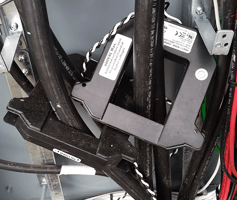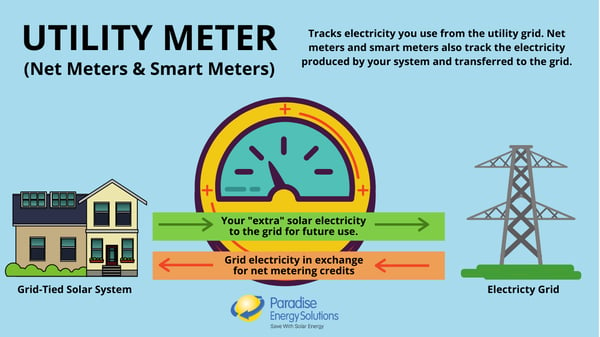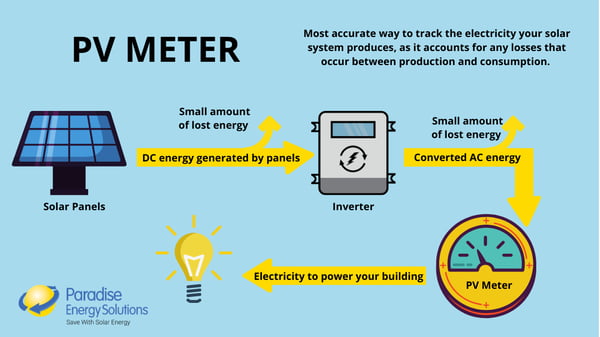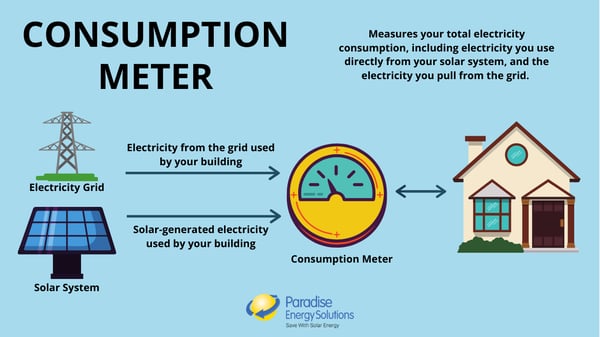Understanding Electric Meters for Solar Panels: A Comprehensive Guide

There’s more to a solar energy system than just solar panels. They’re the star of the show, producing emission- and cost-free electricity from good old sunlight. But they wouldn’t be able to provide you with free electricity without other components like inverters, distribution panels, and meters.
Meters, in particular, are often overlooked components of a solar system. But meters are your connection to your solar investment. They can tell you things like how much electricity your system is generating, how much energy you’re using, and how much energy you are still purchasing from the utility.
In this blog, we want to give meters their due. We’ll discuss each type of electricity meter, how it relates to your solar system, and whether or not you’ll need one.
Types of Electricity Meters
There are two main classes of electricity meters that your home or business could have: pass-through meters and CT meters.
Pass-Through Meters
These are the electricity meters most often installed on residences and smaller buildings. They tend to be larger in size, which makes them less suitable for buildings that require a large electric service.
CT Meters
 CT meters are what you’ll most often see on larger commercial buildings. If the building has single-phase electricity, it will include two CTs. If the building has three-phase electricity, it will include three CTs.
CT meters are what you’ll most often see on larger commercial buildings. If the building has single-phase electricity, it will include two CTs. If the building has three-phase electricity, it will include three CTs.
These types of meters can be much smaller, which makes them ideal for buildings that require a larger electrical service. Pass-through meters for large buildings would require unsuitably large components (the wires, the box itself, etc.).
The following three types of meters will or can be installed with your solar system: pass-through meters, CT meters, and meter-to-meter converters.
Types of Electricity Meters Used with Solar Panels
Utility Meters
What They Do
Traditionally, a utility meter was only used to measure your electricity consumption, running in one direction from your property to the power company.
However, after installing solar, you’ll have a few more metering needs that can’t be fulfilled by a traditional one-way meter. Instead, many solar systems are equipped with net meters or smart meters. These run bi-directionally, allowing them to properly account for the net energy you’ve used, which is all the energy you’ve consumed minus the energy your solar system produced.

Why Your Utility Meter Should Also be a Net Meter or Smart Meter
Most solar systems are not independent of the utility grid. These systems are called grid-tied systems, and combine the cost-saving, energy-independence elements of off-grid solar power with the easily accessed electricity from the power grid.
You can offset 100% of your usage with a grid-tied solar system. However, a solar system can only produce electricity when the sun is shining, and you’ll need electricity regardless of the weather or time of day. To get around this, your system will be designed to produce “extra” electricity while it’s sunny out.
You can then use the extra energy when your system is not producing, but that extra electricity needs to be stored somewhere in the meantime. There are two main options for this: batteries or the utility grid.
Batteries are most commonly used in small-scale residential applications. Although technology and prices continue to improve, batteries come with a high price tag, making them cost-prohibitive for a lot of homeowners.
The other option, the utility grid, is the most popular and affordable. Thanks to a program called net metering, which is available in many states, you’re able to store excess electricity on the grid, and you’ll get a credit from the utility company. Then, when your system is not producing, you can pull electricity off the grid in exchange for those credits.
This is where bi-directional utility meters are essential. Instead of just measuring the electricity you draw from the utility grid, they’re also measuring the electricity you transfer to the grid. This net usage will show how much electricity you added from the grid in relation to how much electricity you used from the grid, resulting in either a surplus of credits or a charge from the utility.
Do You Need A Utility Meter With a Solar System?
All owners of a grid-tied solar system will need a bidirectional utility meter to monitor the electricity the system transfers to the grid.
PV Meter
What They Do
A PV meter is used to measure how much electricity your solar system generated. This is a one-directional meter, as you won’t be transferring power to your solar system.
It is the most accurate way to measure exactly how much usable electricity your system is generating, as monitoring it at the panel- or inverter-level won’t account for the small amounts of lost production as the energy flows from one component of your system to the next.

Do You Need a PV Meter With a Solar System?
This meter can be used for Solar Renewable Energy Credits (SRECs) if you live in a state that has an SREC market and performance guarantees.
SRECs are a credit you get for every 1,000 kilowatt-hours (or 1 megawatt-hour) your system produces. You can then sell these on your state’s SREC market at market price for additional income from your solar system.
At Paradise Energy, we guarantee the performance of our systems with our Triple 10 Guarantee, so tracking solar production is critical. If your system doesn’t produce what we estimate it will, we’ll literally pay you the difference.
If you are able to and are planning on selling your SRECs, or if your solar installer offers a production guarantee, you will need a PV Meter.
PV Meters Connected to the Internet
Many PV meters will need to be connected to the internet. This makes it much easier to monitor your solar system’s production.
Instead of having to physically go outside and read the meter, you’ll be able to do so via your computer or smart device. Many inverter manufacturers (such as SolarEdge, SMA, and Enphase), work directly with metering companies to integrate this information into the system’s dashboard or online portal, where you’ll be able to keep tabs on your system.
Internet-connected PV meters also make it easier for your installer to remotely monitor your system and honor their performance guarantee.
Most PV meters with an internet connection will be CT meters, regardless of the size of your electricity service.
Consumption Meter
What They Do
The consumption meter will tell you exactly how much electricity you’ve used, including electricity used directly from your solar system and electricity pulled from the utility company. These are almost always CT meters, regardless of the size of your building.

Do You Need a Consumption Meter With a Solar System?
If your solar installer promised you a system that meets 100% of your electricity needs, and it’s falling short, it can be helpful to take a closer look at your overall electricity consumption.
Increases may not always be easy to spot, as seemingly small changes to your home or business could result in a notable increase in your electricity consumption. Or, your solar system may have been designed too small to meet your electricity needs.
Either way, a consumption meter can help get to the bottom of what’s causing the discrepancy.
Many inverter manufacturers are beginning to include consumption monitoring in their inverters, giving solar system owners greater insight into their electricity usage.
While a consumption meter isn’t a necessary solar component, it can be useful to determine your exact electricity usage. And as more inverters and adding this as a feature, it’ll likely become a more commonplace feature of a solar system.
Accessing the Vital Information for Your Solar Investment
While not the first thing you think about when installing a solar energy system, meters play an important role in understanding and monitoring your solar investment. In addition to being essential components, whether for net metering, SRECs, performance guarantees, or just peace of mind about your investment, they’ll give you a look into how your solar system functions and your own electricity usage.





